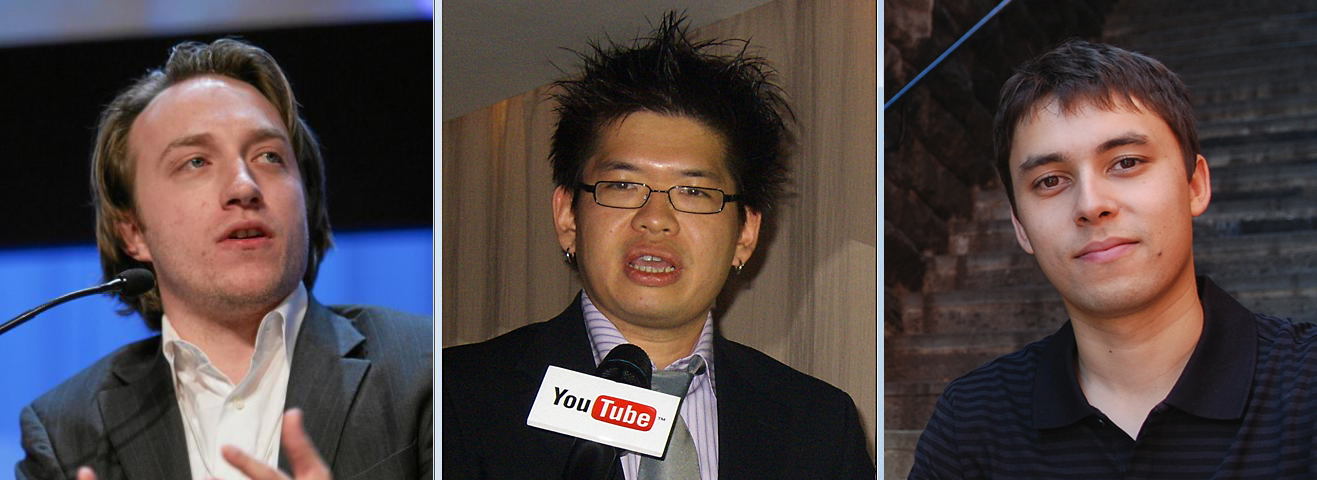The first video on "YouTube" turned 10 years old
On April 23, 2005, the video Me at the zoo presented above was published on YouTube. The main character is Javed Karim, who tells about elephants in a silly manner while being in a zoo. He especially notes their “long trunks”. The video was filmed by Yakov Lapitsky, Karim's classmate, and at that time he had almost no idea what the footage would be used for. Karim is one of the co-founders of YouTube, who was directly involved in its development. But his fate in the role of the company has developed in a peculiar way.

“YouTube” would not have been without the PayPal payment system. The three founders of the site, Chad Hurley, Steve Chen and Javed Karim (left to right), were former PePal employees who joined the company at the time of growth.
')
The idea of the site was born precisely when it was possible to implement it: the necessary bandwidth of the users channel and the demand for it appeared. The Internet then almost entirely consisted of images and text. On December 26, 2004, a tsunami occurred off the coast of Indonesia, and in January, Janet Jackson’s breasts were exposed for half a second during the Super Bowl. Karim found that finding videos of these events on the Web was almost impossible. Today, the co-founders differ in their assessments of each other’s activities in the early days of the site’s development. But at least in one they agree: the work on YouTube began on February 14, 2005. That day the domain name of the site was registered, which was chosen shortly before.
Karim was inspired to create “YouTube” by HotOrNot, a dating site where people were asked to rate strangers on a ten-point scale. It was one of the first sites where you could upload your content and let other people view it, Karim recalls . Until that moment, everything was clear: the content is made by the site owner, not the visitor. By the way, HotOrNot inspired another famous geek - it was Mark Zuckerberg, who made Facemash, a clone with photos of students at Harvard University.
The channel for the first version of the site cost $ 129 per month, and for a long time the traffic was the only expense item - the workers were not paid. Initially, there were very few visitors, and the resource itself was primitive. It was impossible even to choose what to watch - “YouTube” was losing videos in a random order, and since there were not many of them, repetitions constantly occurred. It was then that the 18-second “I at the Zoo” video was published.
Even the founders themselves did not know what YouTube would become. It was believed that this is a dating site. Karim stuffed the resource with rollers of takeoffs and landings of passenger airliners, so that there was at least something on it. In general, he was quite active in the development of the company. To attract anyone, YouTube members offered $ 20 on Craigslist to any girl who uploads her video. No response was received. Another idea was to try to create a site for a video among friends and relatives, Chen recalls . But the exact opposite happened: the site has become a platform for hosting videos all over the Internet.
The story of the protagonist of the first video "YouTube" ends. Karim left the company and went to graduate school at Stanford. This decision was reasonable - then “Youtube” had a very uncertain future. Ironically, Karim never received his doctorate. By the end of the summer, Sequoia Capital had invested the first 500 thousand dollars in the site. For a while less than 10 people worked on the site, everyone did it from home. Later they moved to the large Sequoia office in Menlo Park, then to the office in San Mateo. In the latter, the rats ran, and the company could not afford the partition walls, so the staff managed with curtains.
“Youtube” developed and grew, but almost without Karim. The times were changing. On July 4, 2005, Kate Rabois from the investment firm Khosla Ventures, asking Javed, asked the question: Does the site use Flash? Today, HTML5 allowed “YouTube” to completely abandon this plugin, and then Flash was considered the future of the web. In 2006, the site was bought by Google giant for $ 1.65 billion, of which 64 million went to Karim. Today, YouTube is one of the largest traffic generators on the global network, with hundreds of hours of video clips being downloaded every minute. But ten years ago, spreading a weird 18-second fragment from the zoo with his participation in the public domain, Javed Karim could not even guess what was going to become his product.
Source: https://habr.com/ru/post/366893/
All Articles